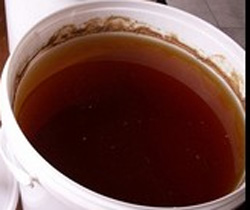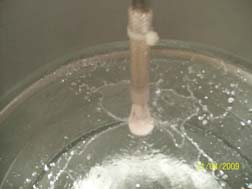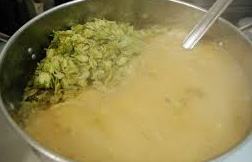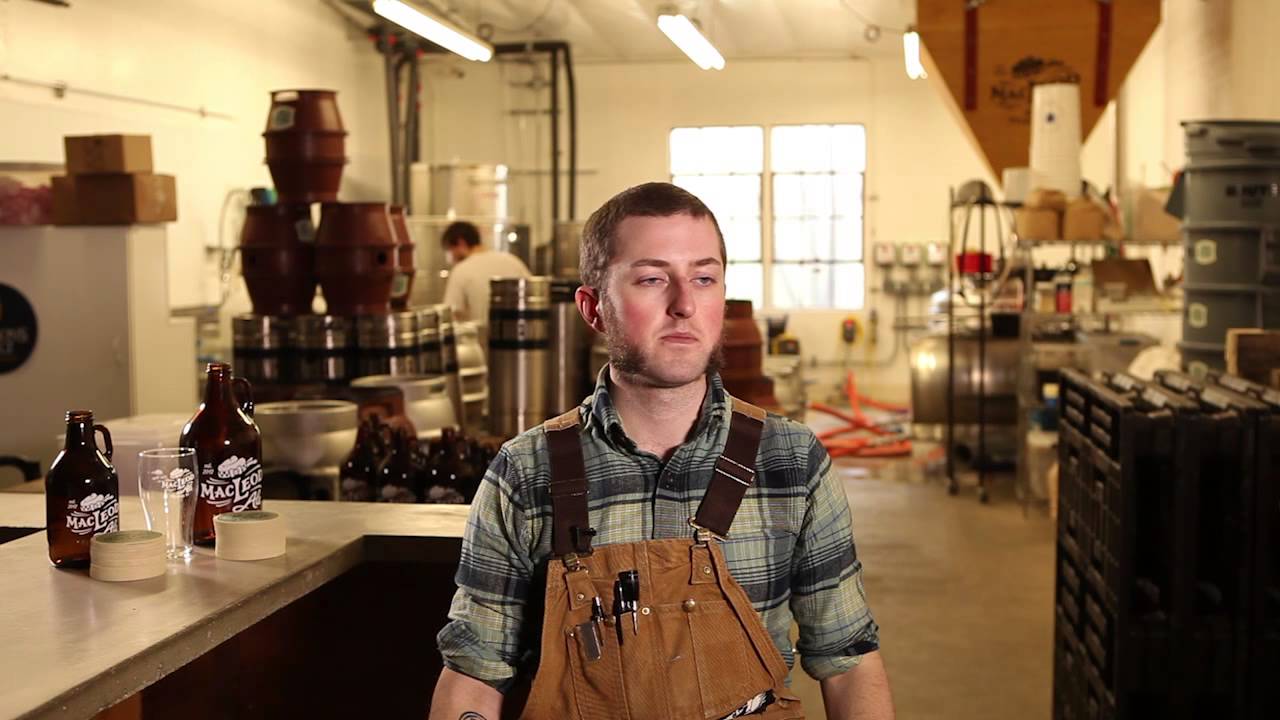Pronounced “wert”, originating from the Old English wyrt. Do not give away that you are a newbie using the wrong enunciation.

Contents
Beer Before Fermentation
Wort is the liquid drained from the mashing process and is strange tasting and sweet. As you become an experienced brewer, you may learn to enjoy tasting it and even learn to predict how the beer might taste after fermentation.
Especially the flavor and aromatics like bread, toast, nuts, coffee, caramel, toffee, chocolate, biscuit, and honey. Hops may dominate the aroma.
We will attempt to take you through the various steps of wort production here. Wort production involves dried barley malt or other grain and mashing it. I will discuss the different mashing methods the brewer can use. Most of the starches from the grain malt turn into sugars. These sugars are used to flavor the beer and assist with the fermentation process

Next we lauter the wort
Which just means rinsing the sweet wort from the mash, and usually there are three stages involved in the process. They are mashout, recirculation and sparging.
Mashout
Raising the mash temperature to 170o stops all enzyme activity plus makes the wort and grain bed fluid. We might compare this to the difference between pouring cold and warm honey. There are different techniques that are used to raise the temperature; direct heat or adding water.
Recirculation
Collecting and pouring the first few quarts of wort on top of the grain bed. This first collection of the wort is always dark and a little bit cloudy (with the undesired material (debris and protein). This step removes the debris and protein preventing it from getting into the boil kettle. When the wort runs clear, we are ready to collect the wort by rinsing (sparging) the grain bed.
Sparging
Extracting as much sugar from the grain bed via rinsing with about 1.5 times more water than the mashing process volume used. This rinsing water should be no hotter than 170o to prevent the extraction of tannins (mouth-puckering, like sucking on the grape skins.) There are three techniques used to sparge, English, Batch, and Continuous.
Next we Boil
The primary qualities boiling effects are; final beer gravity, bittering, flavor, color, purity and clarity of the beer we brew. One step of all the brewing processes that home brewers have a tendency to pay little enough attention to is the boiling of the wort. Many don’t think there is much of anything going on in the boil, just adding heat, bring it to a boil and add hops from time to time (Hop schedule).
However, to brew a good beer the boil is essential for the following reasons.
- Accommodating of the hop schedule.

Hops contribute aroma, some flavor, and their oils give the beer a bittering quality. Without hops, almost all beers would be sticky (cloying) sweet, it is the hop bitterness that balances the malt sweetness. Without the balance between malt sweetness and bitterness, the beer would be almost undrinkable, accommodating the hop schedule is a very critical step in the brewing process.
When brewing from a recipe the hop addition schedules are included when brewing from a recipe, and each step develops a different hop profile for your beer.
First hop addition – During the boil hops will break down, and the color and flavor, the delicate aspects) will precipitate away. Leaving the hops in the boil longer, the greater amount of the bitterness qualities get absorbed into the wort. The brewer controls the amount of bitterness by regulating the amount of hops and the length of time they are in the boiling wort.
Other hop additions – These additions near the middle of the scheduled boil or the end. If near the middle, you add a small amount of additional bitterness and flavor. The closer to the end of the boil the hops go into the boiling wort the more hop aroma and flavor will be apparent – meaning hoppier beer. Hops added at or near the end of a boil create very little or no bitterness.
How do you determine hop bitterness?
A quality imparted in a beer by the addition of hops during the brewing process is perceived bitterness. By using International Bittering Units (IBU – the standard of measurement), the function of alpha acid concentration in a strain of hops and a total boil time of wort can be measured.
How bitter should your beer be?
The beer style is one determining factor; sweet malty beer styles require more bitterness to achieve a balance. And, of course, the converse is true, less malt, less bitterness is needed. Of course, the apparent bitterness of the beer is subjective to the taste of the drinker.
The formula for calculating IBUs is:
Wh × AA% × Uaa ⁄ Vw
where:
Wh represents the weight of the hops
AA%: the percent of alpha acids present in the hops
Future articles I will publish all the various formulas that are available for brewers if you are one of those guys that just loves to work with them.
- Sterilizes the wort,
Reducing the chances of contamination.
- Reduces the amount of water from the sparge.
Concentrates the sugars.
- Denature the enzymes that are active in the mash after the mash out and sparge.
We denature the enzymes by the means of physical action;
Increase temperature. (boiling)
Besides adding bitterness, aroma, and flavor to the beer, hop polyphenols aid in the process attracting and removing harmful malt proteins. Polyphenols will actively move about in the kettle and gather when the wort is in a vigorous boil.
Little clouds of polyphenols will form during the boil, which will precipitate (fall) to the bottom of the kettle at the end of the boil. Known as the HOT BREAK and removes the worst of the harmful proteins, the ones that can cause off-flavors and instability.
Get a sample of the hot wort, suspended flecks of protein in the sample mean you have achieved hot break. At flame-out, the agitation from the boil will stop, and the protein flocks will settle to the bottom of the container. When the protein is not apparent in your next sample, you will know you have achieved hot break.
Change the pH
To create an efficient break pH levels between 5.0 – 5.5 should be maintained to aid in the full precipitate the harmful proteins out of the wort. Use acid or calcium carbonate to regulate the pH level. You will have some pH drop during the boil naturally, but only .2 to .3, so no need to worry about being too low once you adjust to the target range.
- Stabilizes the different proteins.
Prevents side effects in beer.
Chill haze.
Cloudy beer.
Off-flavors.- Undrinkable beer.
To completely stabilize the wort you will want a rolling boil for at least an hour. However, some proteins contribute to important aspects of the beer, such as; color and mouthfeel, so we don’t want to remove all of them.
Boiling Extract Wort
You face a unique challenge when brewing extracts for an extract beer, due to the fact, we are only using a fraction of the water, if not careful we can scorch the sugars in the extract. Since scorched sugars are non-fermentable, the beer will be sweeter, meaning, less alcohol than desired after fermentation. If you are brewing pale ales, for instance, you will have a dark pale ales, not a desirable color.
To prevent the scorching wort from the concentrated wort.(LME or DME)
- Bring your water to a boil first to avoid scorching.
- Remove the kettle from the heat.
- Stir in the extract syrup, and keep stirring until fully dissolved.
- Return the kettle to the heat.
- Bring to vigorous boil the wort so no sugars will settle to the bottom of the pot where they can scorch.Pay attention to details when boiling your wort. Knowing how to manage your wort gives you control over your brewing, which means more consistent brewing.
Brew Tip: Oxygenate Your Wort
Oxygen in beer is undesirable except at one point (and only one point) in the brewing process. That lone point is when the post-boil wort has been chilled down to fermentation temperature, but before the yeast has been pitched into it.
Oxygen dissolves into wort as a function of temperature and specific gravity. As such, the colder and less concentrated the wort, the more oxygen will be able to enter into solution. All the bubbling and splashing that occurs during the boil drives most of the oxygen out of solution because the wort is too hot while boiling. Therefore, oxygen must be replenished after the wort is cool and able to retain the oxygen in solution again.
Oxygen is essential for yeast growth and reproduction. Yeast must grow and reproduce first, before actually fermenting the wort to make beer. Yeast needs oxygen to synthesize the material for expanding cell walls; namely sterols and fatty acids. Overlooking proper wort aeration can lead to problems such as long lag times before the start of fermentation, stuck or incomplete fermentation, or excessive ester (fruit flavor) production, any of which would produce less than desired results.

